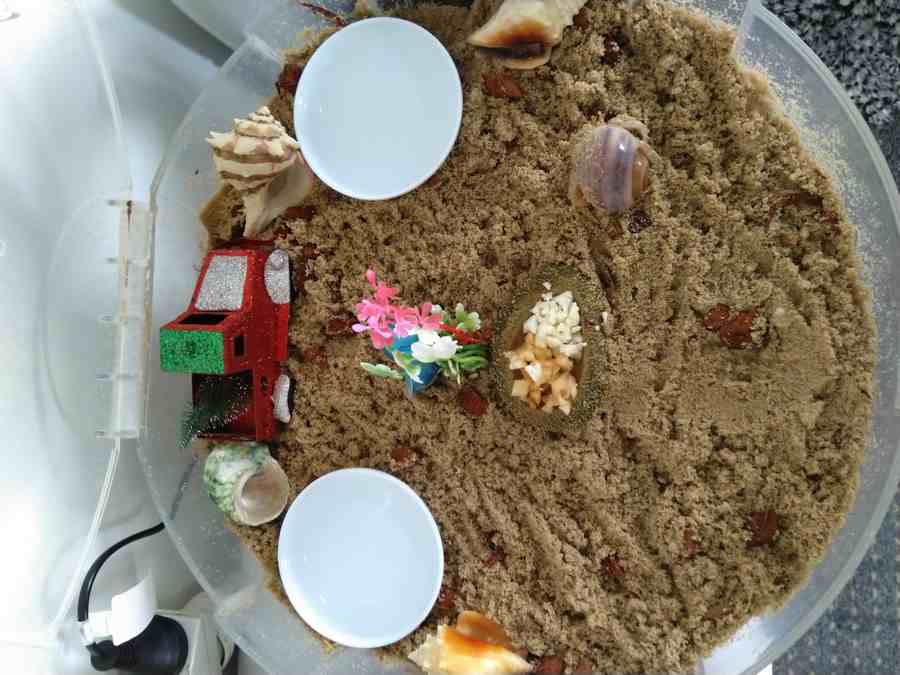When people think of pets, they generally think of cats or dogs, even guinea pigs or fish. However, pets truly can come in a variety of animals. This particularly includes the hermit crab. Hermit crabs are an exceptionally special pet.
At first glance, people might assume that hermit crabs don’t require much care. However, that is far from the truth. Like any other pet in the animal kingdom, hermit crabs require a certain level of care.
Moreover, it is important to realise certain facts about these incredible creatures as well.
What Is The Hermit Crab’s Lifespan?
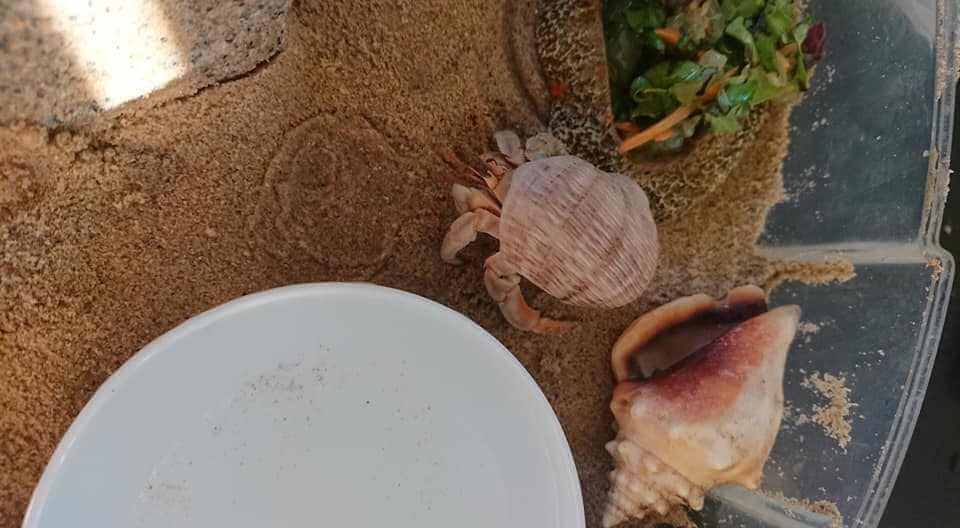
One of the biggest questions any pet owner should know is the life expectancy of their pets. This can be said for new pet owners or those who have had a variety of pets.
Knowing the life expectancy of a pet is important because it helps pet owners be prepared for how long they will care for the pet. It also provides insight into how to properly care for their pet so it lives the longest as possible!
When it comes to hermit crabs, their life span is considered to be a little tricky.
Hermit crabs are crustaceans that are typically found living on saltwater shorelines, within shallow reefs, or even various depths of the ocean.
In their natural habitats, they’ve been known to live up to 30 years. If they are brought into captivity, it’s suggested that their lifespans are greatly reduced. Some say they only live around a year, while others report with the right type of care, they can live somewhere between 10 to 20 years.
This is an incredible amount of time for such a small creature.
So why is there such a drastic change in life expectancy when they are put into captivity? The answer isn’t an easy one. Hermit crabs require a bit of care to help maintain the lifestyles they are accustomed to in the wild.
Sometimes this level of maintenance is not reached, resulting in the unfortunate shortening of their lives. This isn’t to say that this is intentional. Rather, people aren’t always as informed about what certain pets require before getting them.
While this is a sad truth, hermit crabs are still a popular choice among some people. These people strive to give hermit crabs the best life possible. Doing so requires a bit more than people think. They aren’t considered good first pets for children.
It is common for children to lose interest in a pet that might require more maintenance than others. This loss of interest is the main reason why they shouldn’t be considered for children.
There are exceptions to this rule for children who are older, such as teenagers, etc. What it all really comes down to is whether or not the child or adult is willing to put the time and effort into giving hermit crabs everything that they need!
By doing so, it helps keep hermit crab lifespan ranges well within and exceeding the lower end of the scale.
How Can I Make My Hermit Crab Live Longer?
With any pet, we always want to know the best ways to extend their lives. Moreover, we want to ensure whatever time they do have is spent making them happy and healthy!
When it comes to hermit crabs, helping them live longer is directly related to the environment they are living in as well as their diets. These things impact how they thrive and survive within captivity.
Below are specific ways to ensure that your hermit crab has the best environment as well as other tips for a healthy, long life!
Tips and Helpful Information To Help Your Hermit Crab Live Longer
Make Sure Your Hermit Crab It Has A Proper Habitat
The habitat that a hermit crab lives in is the foundation for its life. It is where it spends all of its time. If the habitat is not suitable for a hermit crab, it can cause issues. ideally, the habitat should be within a glass enclosure.
Aquariums are the most popular choice and starting with the proper size is the first step. They should be kept in tanks that measure about 38 to 75 litres (or 10 to 20 gallons).
This provides ample space for the crabs themselves as well as the other things in their environment. The tank should have a ventilated lid as well.
Another large part of having a proper habitat is the substrate that is used. Hermit crabs need an appropriate substrate because they use this for burrowing.
The substrate typically comes in the form of sand, either playground sand or aquarium sand. This is considered the best type of substrate because it is soft and easy to burrow into. The depth of the substrate should be around 10cm (or 4in).
You Should Have More Than One Hermit Crab
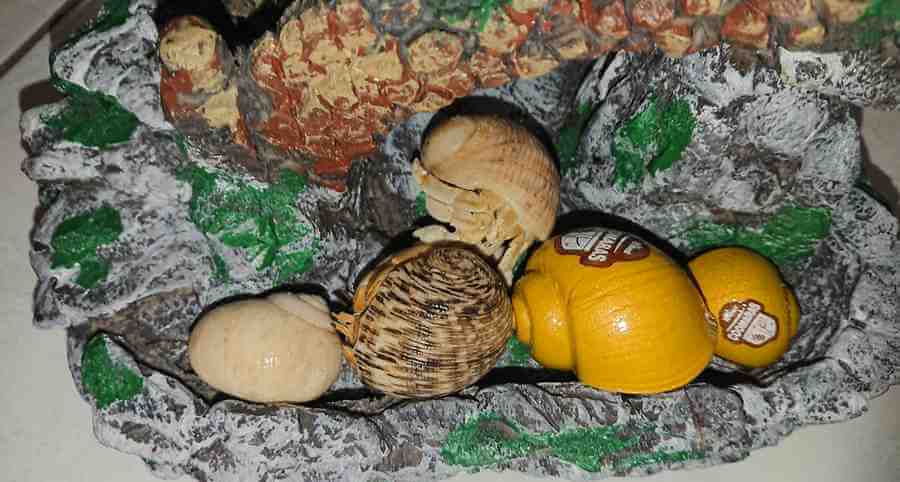
Hermit crabs are quite the social butterflies! They always thrive better when there is more than one hermit crab. Keeping only one hermit crab can shorten their lives because they could die of loneliness.
Once again, having an appropriately sized tank is critical. Having a tank too small can be quite uncomfortable. There’s no harm in having more space. so choosing the larger tank size is always a good rule of thumb.
Keep The Hermit Crab Tank Clean At All Times
The tank can get dirty from waste, food bits, etc. It is important to keep the tank properly cleaned. This prevents mites from forming (which can be deadly to hermit crabs) as well as keeping their overall health and mentality stable.
The substrate should be cleaned using a scooper like a cat litter scooper to remove any unwanted bits. Always make sure that no crabs are lifted up with the sand. You don’t want to drop them, they are fragile!
Another critical part of cleaning the tank is wiping down the interior glass. The crabs should be carefully placed in a small container with food and water while this is done.
The glass should only be wiped down by hot water. Commercial cleaners can contain chemicals that aren’t safe for the crabs. Moreover, the objects in their tanks like driftwood, ropes, etc should be wiped down or changed out regularly.
Keeping the same items in the tank continuously can cause mites. It is simply an unclean environment.
Always Provide Your Hermit Crab An Appropriate Diet
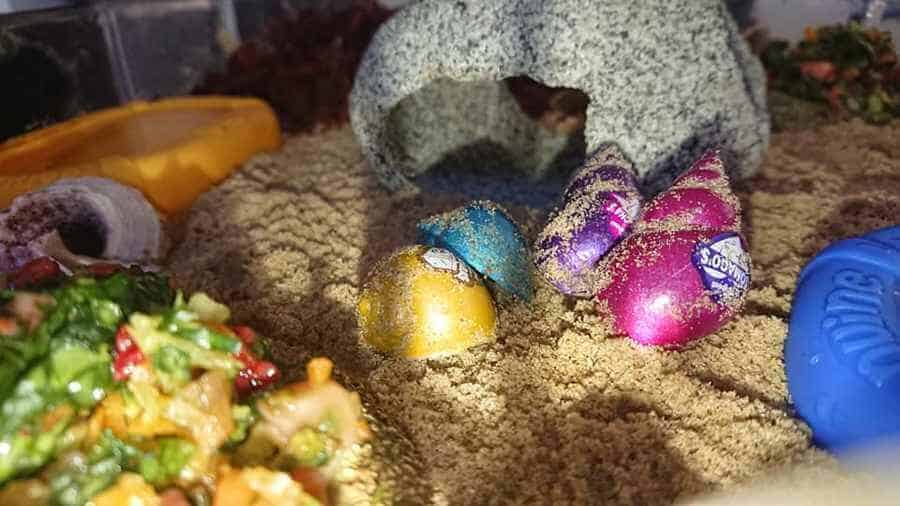
The food that a hermit crab eats helps maintain its life, just like other living things on the planet. The best way to make sure that a hermit crab is living a good, healthy life (and the longest possible life!) is to provide it with the proper food.
Foods that hermit crabs can eat include veggies (like spinach, lettuce, carrots, etc), fruits (like coconut or mango), fish pellets or flakes, seaweed, brine shrimp, boiled chicken, beef, or salmon and cuttlebones.
They are omnivores meaning they eat veggies and meat. All meat should be cooked thoroughly though not seasoned. They enjoy a wide variety so changing up the food they get keeps them mentally happy as well!
Provide Your Hermit Crab Clean Water Sources Of Salt And Fresh Water
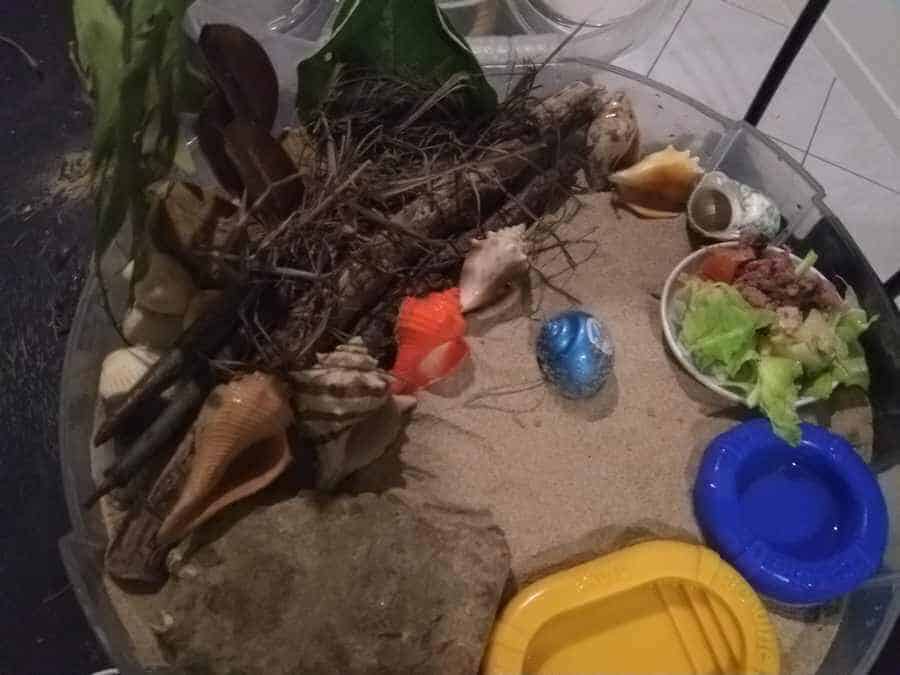
Despite them being found in ocean areas and shorelines, hermit crabs do not need to be completely submerged in water. When in captivity, they should have access to two shallow bowls of water, one for drinking and one for bathing.
The water should only be deep enough to get the crabs mostly covered, not submerged. The bathing bowl should contain salt, while the other bowl should not.
It is important that the salt is NOT table salt, as this could be harmful to your crab. Many online retailers and pet shops sell marine salt, which is a suitable salt to use.
How To Maintain Hermit Crabs Tanks Humidity Levels
Humidity is extremely important for hermit crabs. Humidity refers to how much water vapor is in the air. If there isn’t enough humidity in a hermit crab’s tank, they could suffocate.
The humidity levels should sit somewhere between 75 and 85%. There are humidity readers for sale online or in pet stores that will measure the percentage within the tank. Investing in one of these is a great idea.
If the humidity level starts to drop, there are some ways to increase it. This includes misting the tank with dechlorinated water, adding more water bowls to the tank, or adding moistened moss to the tank.
This creates more water vapour in the air of the tank, thus keeping the percentages higher.
These aren’t necessarily the only wants to help a hermit crab live a long, healthy life but they are the most important ones. Hermit crabs are interesting creatures and the proper care of them can result in them living longer!
Hermit Crabs Lifespan In Captivity
As expressed before, the lifespan of hermit crabs in captivity can vary depending on the care hermit crabs receive. Their lives can be a few months to a year to anywhere between 10 to 20 years.
The lifespan directly correlates with the care the hermit crabs have. This is why it is important to know all the right things to give a hermit crab as well as how to maintain their tanks and lifestyle.
A huge contributor to the shorter lifespans is sometimes related to their molting.
A molting hermit crab often gives off the illusion of a dead crab. They tend to lay on their sides or back when molting from their shells. When a hermit crab is outgrowing their shell, they are required to molt.
Sometimes, they will bury themselves under the sand to molt. This process is extremely difficult for owners to determine if the crab is alive or dead since the two things look so similar. Due to this, hermit crabs are mistaken as dead and end up disposed of.
In an effort to make sure that a hermit crab lives the longest life possible, you should always investigate the hermit crab first before jumping to any conclusions.
Molting is a natural process and it is necessary so that the hermit crab sheds its current shell. For hermit crabs that are on the surface of their substrate, laying on their backs or sides, they usually will appear partially out of their shell.
Sometimes, they can be seen moving ever so slightly when in this position. It is important not to disturb them during this process. Nature must take its course. This investigation should only be done with your eyesight, not by actually touching the hermit crab.
The safest approach is to simply assume it is molting and let it be!
Molting signs also include little tracks in the substrate indicating the hermit crab has propelled itself ever so slightly through the substrate while molting. Moreover, there can be some exoskeleton visible.
The process of molting can take anywhere from 4 to 8 weeks! This might be a painstaking process but is important to their health, especially in captivity.
Any creature in captivity generally has a shortened lifespan. This tends to be due to the creatures not being in proper environments or having access to appropriate diets.
This isn’t to say that you shouldn’t keep hermit crabs or other creatures as pets. It is possible and can be done humanely. Hermit crabs might not be a typical pet, however, they are super fascinating to watch while they interact with their environments.
Things like ropes or driftwood pieces provide space for them to crawl and climb and watching them use their bathing bowl can be fun too. They are so much more than a little crab from the ocean.
Lifecycle Of A Hermit Crab
Nature is always amazing us and this is particularly true when examining the lifecycle of certain animals or creatures. While looking at the lifecycle of an animal or creature is interesting, it is also helpful information.
Knowing the lifecycle keeps us informed of how their lives play out in a general sense. This ensures that owners of hermit crabs take even more care of their unique little buddies. Below is the lifecycle of a hermit crab!
1. They Start Out as Tiny Eggs
Hermit crabs being life as eggs. The eggs get fertilised and then are carried on the left side of a female’s abdomen. There are typically thousands of eggs within this process.
The eggs are carried until they reach a darkened gray color. When they get to this color, their yolk-sacks have been entirely diminished. This means that the eggs are ready for the next step in their journey to life.
2. Eggs Start To Turn To Larvae And Hatch
The next step in the lifecycle of a hermit crab is for the eggs to hatch into larvae. These eggs are released directly into the waters of the ocean. Once the saltwater touches the eggs, they instantly burst and become larvae.
The resulting larvae stay in the ocean for quite some time. During this time, they survive on plankton and undergo physical changes. These physical changes make the larvae start to resemble a cross between a hermit crab and a lobster which is generally called a megalopa.
This transformation is a critical one in becoming a hermit crab.
3. Transformation Into An Adult Hermit Crab
The megalopa appears to have elongated bodies and it is at this stage of their life that they begin searching for empty shells to call home. This search requires them to make their way closer to land.
Their need to be submerged in the waterways is no longer needed and they must find an empty mollusk shell to call home. After one is found, the megalopa often burrows into sandy flats or shorelines. This process allows them to continue their development into adult hermit crabs.
Mating Practise Of Hermit Crabs
Hermit crabs mate to continue their lifecycle. Mating for hermit crabs doesn’t look like typical mating practises. Their mating takes form when a male and female slightly come out of their shells and the male transfers a highly concentrated reproductive material to her.
This is used to fertilise the eggs that the female then carries on her left abdomen. Thus, the lifecycle continues again!
It is incredibly fascinating to see how a land hermit crab, which is the most common that are kept as pets, start their lives. Moreover, it goes to show that these crabs have a truly unique atmosphere for them from the very start of their lives!
Typically, hermit crabs will grow to be around 15cm (or 6in) in size. They are often considered small, however, they can grow bigger than most people would assume!
Hermit crabs aren’t necessarily a very common pet but they have proven to be quite an interesting one! As stated before, they shouldn’t be considered “starter pets” for children due to the overall care they require.
This care also goes hand-in-hand with their lifespan. It has been shown that a hermit crab lifespan can greatly differ depending on the care and overall environment in which it is living.
The important to remember is that it is possible to give your hermit crab a full, long, and happy life! For a hermit crab to live between 10 to 20 years in captivity is truly remarkable and it is possible!
There have been claims that some have lived even longer. No matter what, these uncommon pets are great companions for those looking for a pet that is exceptional!
More Pages On Hermit Crabs
Before keeping a hermit crab from the beach, it is important to be fully prepared for having a hermit crab at home. This includes having a proper tank, all the supplies it needs, and proper food....
There are around 800 species of hermit crabs that are found in the ocean. The hermit crabs that are kept as pets are typically a species called "land hermit crabs". These do live near shorelines,...


